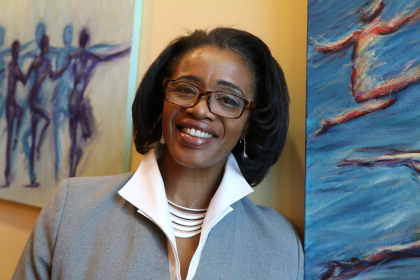Pamela M. Green Dance/USA 2022 ‘Ernie’ Award Recipient: A Facilitator of Artist Dreams
A Q & A with the Arts Management Leader
By Steve Sucato
 A guiding phrase in artist manager Pamela M. Green’s career has been, “Tell me what your dream is, and I will try and make it come true.” It is both a goal and a promise by her to do her very best for the artists she represents. It is something she has largely lived up to in a career that has spanned more than three decades. Mrs. Green, who officially retired her arts management company PMG Arts Management in July of 2020 , is still on the job because of several outstanding engagements postponed due to the pandemic. Her next career move she says, will be as interim managing director for Ronald K. Brown.
A guiding phrase in artist manager Pamela M. Green’s career has been, “Tell me what your dream is, and I will try and make it come true.” It is both a goal and a promise by her to do her very best for the artists she represents. It is something she has largely lived up to in a career that has spanned more than three decades. Mrs. Green, who officially retired her arts management company PMG Arts Management in July of 2020 , is still on the job because of several outstanding engagements postponed due to the pandemic. Her next career move she says, will be as interim managing director for Ronald K. Brown.
Mrs. Green earned a BA in Public Policy and a minor in Drama from Duke University and an MS in Arts Administration from Drexel University. She began her arts administration training at the Durham Arts Council and furthered it working for the American Dance Festival. From 1985-1989, she was company and managing director for The Chuck Davis African-American Dance Ensemble, and was the director of touring and presenting for the North Carolina Arts Council from 1989-1992.

Pamela M. Green and Chuck Davis
In 1992 Mrs. Green founded PMG Arts Management to provide booking, consulting, management, producing, and touring services to established, mid-career, and emerging artists including Ronald K. Brown/Evidence, Camille A. Brown & Dancers, Philadanco!, The Chuck Davis African-American Dance Ensemble, The Cleo Parker Robinson Dance Ensemble, Bebe Miller, Karole Armitage, Rosie Herrera Dance Theater, Helen Simoneau and many more. Mrs. Green has been instrumental in the career development of choreographers Ronald K. Brown and Camille A. Brown among others. Some career highlights include her production and tour arrangements for One Shot, RKB/Evidence’s commission to open Pittsburgh’s August Wilson African American Cultural Center that also toured nationally with a photo exhibit by Charles “Teenie” Harris. She has helped secure funding, creative development, and touring resources for many of the major works in the EVIDENCE repertory. She helped produce, tour, and provide creative development support for Camille A. Brown’s trilogy of works on African American identity.
Mrs. Green has served as a board member, consultant, panelist, and/or workshop leader for the National Endowment for the Arts (NEA), the Association of Performing Arts Professionals (APAP), the New England Foundation for the Arts (NEFA), the International Association of Blacks in Dance (IABD), the North American Association of Performing Arts Managers and Agents (NAPAMA), and the City of Durham North Carolina’s Cultural Advisory Board. She received the 2017 NAPAMA Liz Silverstein Award for Agent-Manager of the Year.
Mrs. Green will receive Dance/USA’s ‘Ernie’ Award at the Dance/USA 2022 Awards Ceremony, on March 10. The honor is given to an individual who has demonstrated extraordinary leadership, outstanding value in the field, and whose achievements have influenced and significantly advanced the work of artists and supported their creativity. Named for the late dancer, choreographer, director, AIDS activist and champion for the field, Ian ‘Ernie’ Horvath, the ‘Ernie’ recognizes Mrs. Green’s long history of service in arts management to the national dance community.
D/USA: What are your thoughts on receiving the ‘Ernie’ Award?
P.G.: It is a beautiful recognition. I think everybody who has survived COVID and is still viable in the dance field deserves an award. It’s very humbling to get an award when so many of us are struggling to survive in this environment. I am appreciative of the recognition of my body of work that I am very proud of.

Pamela M. Green and Ronald K. Brown when Brown received the Samuel H. Scripps/American Dance Festival Award.
D/USA: What got you interested in arts management?
P.G.: Growing up in the greater Boston area I had some great examples of it such as Elma Lewis, the founder of The Elma Lewis School of Fine Arts who also presented a series of free concerts in Boston’s Franklin Park. She was the first presenter I was aware of. My parents, a mechanic and a nurse, were both very culturally aware. They loved jazz, and my mother always got us tickets to see shows. Also, seeing Alvin Ailey American Dance Theater perform and seeing myself and my culture being represented on stage in such a beautiful way was inspirational for me. I think all that influenced me to wonder from a business standpoint, how do you put these things on stage and get people to pay to come and watch? When I went to Duke [University] , I decided I would try to find out. My career progressed from there.
D/USA: What are the top assets/qualities that you feel make for a great arts manager?
P.G.: The ability to listen deeply not only to the artist, but to the presenters and funders in the environment you are trying to put the artist into. Having respect for the artist as a creative being and their wishes and process is very important. Also, I think integrity is a bedrock of what is needed in our field and being honest and transparent in what you can and cannot do. The overriding quality must be a passion for the kind of voice you want to support.
D/USA: Name three of your proudest moments in your career?

Pamela M. Green striking a pose with a cut out of Camille A. Brown.
P.G.: One would be helping Camille A. Brown achieve her dream of having a dual career in concert dance and commercial theater. Another is the over twenty-years I have been able to stay with Ronald K. Brown sustaining the level of his touring and creation of works. If I had to pick a moment from that, it would be the first large commission I got for him from the American Dance Festival for his 2001 quartet “Walking Out the Dark”. It remains one of my all-time favorite pieces. It’s so beautiful in its storytelling. The third would be the lovely things people had to say to me during my retirement Zoom party. That brought a nice conclusion to that part of my career. But perhaps the biggest satisfaction of my career is having sat down with an artist three years ahead of time and asking ‘what do you want to do?’ and having them write that dream down on paper, and then three years later seeing the curtain go up on that dream and knowing that I had a lot to do with making it happen.
D/USA: How has the state of the Arts Management field changed since you started in 1992?
P.G.: It is so much more electronic now, so we all have to be kind of digital experts to communicate our messages. I still think it is a very personal one on one relationship building kind of business. It has just changed in how we accomplish that especially during the pandemic when we couldn’t meet in person. Also, I feel the basic 501(c)(3) model has become kind of broken. I am proud to be a part of efforts to find alternative models to it. I also think dance-on-film has become a more important part of the dance world and the arts management field. I would like to see more integration of that with live performance events as a marketed package.
D/USA: What advice do you have for the next generation of arts managers/leaders?
P.G.: Go and see as much dance as you can possibly see. And when something that really strikes you in your heart, utilize that feeling to figure out how you can translate it into your goals as an artist agent or manager. Find your passion. Mine is African American dance, culture, history, and storytelling. Don’t be afraid to focus on that passion and make it your core value and mission.
All photos courtesy of Pamela M. Green.
 A former dancer turned writer/critic living in Ohio, Steve Sucato studied ballet and modern dance at the Erie Civic Ballet (Erie, Pa.) and at Pennsylvania State University. He has performed numerous contemporary and classical works sharing the stage with noted dancers Robert LaFosse, Antonia Franceschi, Joseph Duell, Sandra Brown, and Mikhail Baryshnikov. His writing credits include articles and reviews on dance and the arts for The Plain Dealer (Cleveland, Ohio), The Buffalo News, Erie Times-News (Erie, Pa.), Pittsburgh City Paper as well as magazines Pointe, Dance Studio Life, Dance Magazine, Dance International, Dance Teacher, Stage Directions, Dance Retailer News, and Dancer and web publications Cultured.gr, The Rapidian, DanceTabs, and CriticalDance. Steve is also Associate Editor of ExploreDance.com and the creator of the arts website artsair.art.
A former dancer turned writer/critic living in Ohio, Steve Sucato studied ballet and modern dance at the Erie Civic Ballet (Erie, Pa.) and at Pennsylvania State University. He has performed numerous contemporary and classical works sharing the stage with noted dancers Robert LaFosse, Antonia Franceschi, Joseph Duell, Sandra Brown, and Mikhail Baryshnikov. His writing credits include articles and reviews on dance and the arts for The Plain Dealer (Cleveland, Ohio), The Buffalo News, Erie Times-News (Erie, Pa.), Pittsburgh City Paper as well as magazines Pointe, Dance Studio Life, Dance Magazine, Dance International, Dance Teacher, Stage Directions, Dance Retailer News, and Dancer and web publications Cultured.gr, The Rapidian, DanceTabs, and CriticalDance. Steve is also Associate Editor of ExploreDance.com and the creator of the arts website artsair.art.
____
We accept submissions on topics relevant to the field: advocacy, artistic issues, arts policy, community building, development, employment, engagement, touring, and other topics that deal with the business of dance. We cannot publish criticism, single-company season announcements, and single-company or single artist profiles. Additionally, we welcome feedback on articles. If you have a topic that you would like to see addressed or feedback, please contact communications@danceusa.org.
Disclaimer: Opinions expressed in guest posts do not necessarily represent the viewpoints of Dance/USA.




